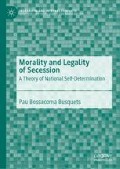Abstract
Secession is defined, for the purpose of this book, as a separation of part of the territory and population of a State with attributes of sovereignty in order to create another State with similar attributes of sovereignty. After defining the concept of secession, this chapter identifies different types of secession and distinguishes secession from other close notions.
Access this chapter
Tax calculation will be finalised at checkout
Purchases are for personal use only
Notes
- 1.
Pavković, A.; Radan, P. Creating New States, p. 5.
- 2.
A similar definition is: “secession is the creation of a new state by the withdrawal of a territory and its population where that territory was previously part of an existing state”. Pavković, A.; Radan, P. Creating New States, p. 5. The Supreme Court of Canada, in the Quebec Secession Reference, also defines secession similarly (see par. 83).
- 3.
Cassese, A. Self-Determination of Peoples, especially ch. 4. Even dissolution could be considered a kind of external self-determination. Dugard, J.; Raič, D. “The Role of Recognition…”, pp. 101–2.
- 4.
Buchanan, A. Secession, p. 10.
- 5.
Since irredentism necessarily involves several States, it is often a (more) destabilizing issue in international relations and it can endanger international peace. Sorens warns that “Irredentism usually requires interstate warfare or threat of warfare to be satisfied”. Sorens, J. Secessionism, p. 11. A recent example of the risk of breaking international relations and peace could be the integration of Crimea into the Russian Federation. See Krisch, N. “Crimea and the Limits of International Law”. Wilson, G. “Secession and Intervention in the Former Soviet Space”, pp. 153–75. The establishment of a cross-border confederal scheme between the parent State where the redentist movement is located and the irredentist adjacent State can be a reasonable settlement. Patten, A. Equal Recognition, pp. 262–3. As the 1998 Good Friday Agreement shows, this kind of accord can offer internal and external peace while legalizing a right of redemption as a consensual form of external self-determination. See § 8.1.
- 6.
In this direction, Pavković, A.; Radan, P. Creating New States, p. 9. Sorens, J. Secessionism, pp. 11, 184. Examples could include the cases of Alsace, Lorraine, Trieste, Fiume, the Aaland Islands, etc. Secessionism and redentism are sometimes mixed up, as in the cases of Northern Ireland (with Ireland), South Tyrol (with Austria), Kosovo (with Albania) and Crimea (with Russia). Since Kurdistan is divided between Turkey, Iran, Iraq and Syria, this could be a case of secession, but of irredentism if a Kurdish State managed to emerge.
- 7.
Gilliland, A. “Secession Within Federations”, pp. 39–49.
- 8.
See § 13.3.
- 9.
See ch. 12.
- 10.
Accordingly, Crawford draws a distinction between secession and devolution, depending on the absence or presence of a metropolitan consent. Crawford, J. The Creation of States…, pp. 330, 375. Consistent with this restrictive definition, Crawford and Boyle distinguish secession, which is mainly unilateral and includes the use or threat of force, from “negotiated independence”, achieved in a mainly agreed and pacific way. Crawford, J.; Boyle, A. Referendum on the Independence…, pars. 22.1, 56.2.
- 11.
Pavković, A.; Radan, P. Creating New States, p. 6.
- 12.
See Buchanan, A. Secession, pp. 15–16.
- 13.
Beran, H. “A Liberal Theory of Secession”, p. 21.
- 14.
The separation of Flanders, for instance, may raise some controversy as the Flemish region has more inhabitants and a stronger economy nowadays. Would it be secession or expulsion? This example shows that geographic and demographic evolution can turn a minority into a majority and so a case of secession into one of expulsion. If it were considered expulsion rather than secession, it could be necessary to reject the right to secede unilaterally and to look for more consensual and constitutional ways to dissolve the Union.
- 15.
See § 2.3. By contrast, Wellman, C.H. A Theory of Secession, p. 74.
- 16.
Buchanan, A. Secession, pp. 14–15.
- 17.
See § 2.7.
- 18.
Buchanan, A. Secession, p. 22.
- 19.
In consequence, as long as the later discussed Principle of viability and compensation is respected, the morality of secession processes should not be confused with the final results that these could cause. Whenever this principle is respected, a final result of dissolution or non-dissolution is a contingency for Justice as multinational fairness.
- 20.
See ch. 7.
- 21.
See Buchanan, A. Secession, pp. 13-4. See § 2.6.
- 22.
See ch. 7. Individual secession would normally lack the territorial element since the individual could not legitimately declare him or herself sovereign over a defined territory. Generally, a government by and over a single person could not exercise the competences and duties that international law mandates to sovereign States. Even if a kind of internal sovereignty could be reached, external sovereignty would not be achieved since the international society would not recognize a one-person-State. The Principle of viability and compensation defended later totally opposes any individual secession.
Author information
Authors and Affiliations
Rights and permissions
Copyright information
© 2020 The Author(s)
About this chapter
Cite this chapter
Bossacoma Busquets, P. (2020). The Concept of Secession. In: Morality and Legality of Secession. Federalism and Internal Conflicts. Palgrave Macmillan, Cham. https://doi.org/10.1007/978-3-030-26589-2_1
Download citation
DOI: https://doi.org/10.1007/978-3-030-26589-2_1
Published:
Publisher Name: Palgrave Macmillan, Cham
Print ISBN: 978-3-030-26588-5
Online ISBN: 978-3-030-26589-2
eBook Packages: Political Science and International StudiesPolitical Science and International Studies (R0)

